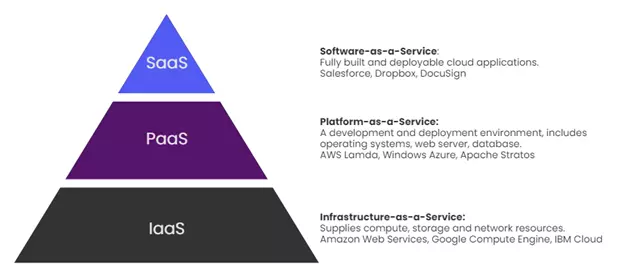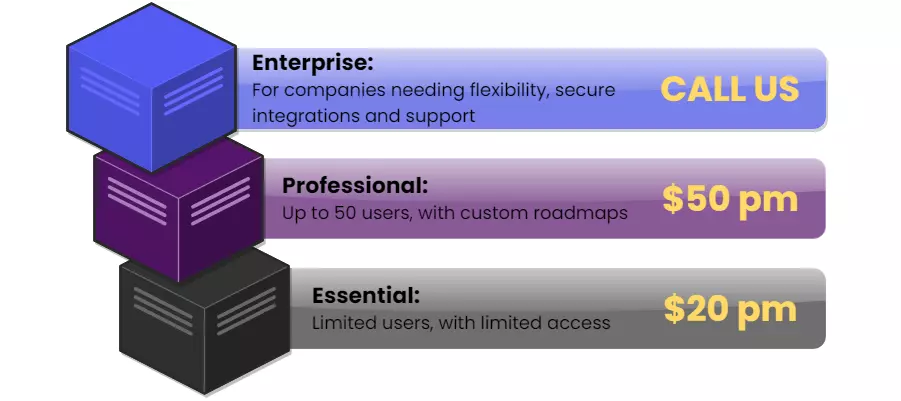Cloud Computing Models: Software-as-a-Service
What is Software-as-a-Service?
Software-as-a-Service or SaaS is a delivery and licensing method for software solutions that are centrally hosted and maintained by a cloud service provider. Also known as Web-hosted or On-demand software, a SaaS allows individuals or organisations to access cloud-based applications over an internet connection from any compatible device. Users of SaaS will subscribe to the applications on a pay-as-you-go or pay-as-you-use basis. The application is then run on cloud servers rather than having the end-user needing to purchase a physical copy and installing it on to a local workstation.
Simply put, SaaS provide software services that are accessed as online applications rather than as desktop applications.
SaaS forms part of an ever-growing number of cloud-based service models, with the majority being variants of the 3 core service models:
Infrastructure-as-a-Service (IaaS); Platform-as-a-Service (PaaS); and Software-as-a-Service (SaaS);

A Brief History
The origin story for SaaS stems from the 1960s, when computing was, well, slow, big and expensive - so just being able to purchase a computer/mainframe was often the biggest hurdle to overcome for a majority of companies. This would lead to the MIT Computation Center developing the Compatible Time-Sharing System (CTSS) operating system.
The early system consisted of a central IBM mainframe, a small number of I/O terminals and tape drives used to swap the users in and out of the system memory, and additional tape drives to hold user data. In 1963, IBM released one of the biggest and fastest computers available - the IBM 7094. Coming in at cool $3.5 million US, that would be a staggering $32 million US in today’s money. It boasted two 32K core memory banks along with a dozen tape drives, a swapping drum and a disk file with a capacity of 36MB. Teletype terminals were supported and connected using dial-up modems via a private telephone exchange held at MIT. Each remote terminal would be assigned a terminal ID and would be given a time in which to dial into the system.
Fast forward a few decades, and computers have become smaller, more powerful and cheaper. Alongside them are Local Area Networks. Companies now have the option to build localised networks, with desktops running the application and passing back important data to be backed up on central servers.
Skip on a little further and we see the emergence of the World Wide Web, and it soon starts to change the entire landscape. As security is enhanced and made safer with data encryption, and access is made faster with improved networking and cloud-based solutions that start to leverage gains that can be found within the new Information Age, the Web and the Internet opens up businesses to the idea of digital transformation.
SaaS Adoption
Like many an industry, SaaS has been on a journey that has hit a few bumps along the way. During its early incarnation, it was seen as a tool merely for fledgling start-ups or smaller businesses that either didn’t have the budget for a full suite of software installs or didn’t have the IT staff available to maintain and manage a large infrastructure. Often being touted as a “passing fad” or perceived as being unstable and slow, larger enterprise companies chose to invest in high-end hardware and dedicated software solutions to deal with their demands.
“Global SaaS sales are expected to reach $145 billion US”
For those same enterprise companies, updating and patching would become laborious and time-consuming. Even when updates moved from physical media to downloadable software files, an original copy of the software was still needed so the base program could be installed. In the SaaS model, this has never been the case, users log on through the Internet, with their device of choice and obtain access to the application via the service provider.
In a world of ever-increasing acronyms, it’s almost hard to believe that one of the first SaaS applications came into existence prior to the new millennium, with Salesforce introducing its Customer Relationship Management (CRM) solution in 1999. Over time, with the internet maturing, networks gaining speed and the rise of cloud computing, it’s no coincidence that SaaS solutions have started to become ever more popular, with a report from Gartner (2021/08/02) predicting the global SaaS sales market for this year (2022) is expected to reach $171 billion US.
Accessibility
The increase and the ease of access to applications and data is one of the huge benefits that a SaaS brings to the table, with users accessing data from anywhere, from any device. This affords companies an opportunity to introduce fully flexible working alternatives when being physically close to hardware is no longer a requirement - employees can still be productive and contribute from any location at any time.
Never has this been so prevalent than during these past few years with the pandemic. The ability to be flexible, and not be bound by “the office”, was crucial in keeping many businesses operating as close to normal. It’s almost inconceivable to think, that what has happened hasn’t only cemented the growth of all cloud-based models, but has also changed how employers structure and operate their businesses and how they engage with their employees.
Costs
There is no getting away from it; no matter who’s doing the buying, the cold hard fact is that cost plays a very significant role in determining whether or not a purchase is made. Typically, SaaS as with the other cloud service models, allows individuals and organisations to sign up using subscription-based pricing terms where the payments are formed of smaller, regular operational expenses (OpEx). This then gives businesses room to manoeuvre, allowing for expansion or to reign in services as required, rather than taking a larger hit upfront from a rigid capital expense (CapEx).

Moving operations to a SaaS may not be the right solution for everyone - it isn’t a silver bullet and on the surface it may not seem the cheapest - but the Total Cost of Ownership (TCO) and Return on Investment (ROI) are two key factors that must not be overlooked when evaluating your different options. As with all technology, the price tends to start high. As it matures and get refined over time, it becomes cheaper, more accessible and more attractive to more people! Are we there yet with SaaS and the other cloud service models? Yes, we are.
That therefore means that using public cloud solutions can actually make more sense than creating and hosting a solution yourself.
One of the cost considerations is that SaaS is also more likely to be supplied with a Service Level Agreement (SLA). SLA’s are performance-driven contracts, and like the rest of the SaaS, it is based on the same factors for all customers. An SLA will set out and define the expectations that the service is required to meet in terms of the quality and availability of the service. If the provider’s application fails to live up to the criteria set within the SLA then the customer will receive some form of credit reimbursement.
SaaS Architecture
A key component of a SaaS is the supporting infrastructure and platform, which is supplied and forms the SaaS architecture.
These architectural environments are centrally hosted, managed and maintained by the provider. Depending on the SaaS design they will either be Single or Multi-tenant.
Single Tenant: With a single tenancy environment, each customer would get their own instance of the SaaS from top to bottom, their own instance of the software, their own compute, their own database, and so on. Vendor and customer benefits include:
- Increased security. As only a limited number of people would be provided access to the environment.
- Reliability. There is less chance of incurring resource conflicts and potentially avoiding noisy neighbors.
- Customization opportunities for additional features and functions.
On the flip side,
- Additional costs. As the might giveth with one hand, they taketh away with the other. There will be some overhead costs with having an abundance of resources dedicated to a single environment.
- Setup of each environment will take more time to manage and roll out.
- Maintaining previous releases.
Multi-Tenant: In a multi tenancy environment every user and every application shares the same underlying infrastructure and runs using the same base source code. Benefits for vendor and customer include:
- Cost efficiency. Having multiple customers running on the same environment, it means multiple customers sharing the overall cost. Any cost savings can then be fed back to help the product development.
- Simple and easy maintenance. The ownership, responsibility and cost of maintaining the hardware belongs to the vendor. There’s no need to nurse ageing servers with squeaky fans and dog eared sticky notes reading “DO NOT TURN OFF!”
- Compatibility. Software updates are rolled out across the board, compatibility issues disappear, and it does not matter if some members of the team run Macs or PCs.
- Increased innovation. Not having to maintain previous and outdated releases means vendor development time can be dedicated on features.
Possible drawbacks:
- Customizations. Because everyone is using the same code, it means that you’re not going to get the same level of control over bespoke changes to the product.
- Noisy neighbors. As multi-tenant environments share pools of resources, there is the possibility that conflicts arise when resources are required. The good news is that there are tools out there that vendors can use to make sure that this is kept to a minimum, such as elastic computing and load balancing.
- Security. Vendors need to ensure that rigid and strict authentication and authorization controls are in place so that customers are protected from accessing one another’s data.
Future Trends
Artificial Intelligence & Machine Learning: The use of AI and ML in SaaS is going to have a big impact. Customer support, for example, enhanced with intelligent and automated chatbots will continue to use ML to automate reactions, it will speed up resolutions, handle and resolve repeating queries, help with onboarding and provide 24/7 assistance across the globe. With security, AI and machine learning can be deployed to detect anomalies in access requests or user patterns, and trigger a response to address the concern or deal with it.
Analytics: Big data is something that continues to grow, and will become more and more important to SaaS companies as they continually move forward with AI and ML integrations. There is a huge amount of data available from any customer/user interactions, all of which can be analysed and used to help understand how different features are used by different users. Gathering this kind of key information can be used to target and help the development of new features, while also being used to identify operational bottlenecks and improve the overall UI/UX experience.
“AI and ML will have a big impact on SaaS”
API Integration: Interoperability is something that businesses and providers will need to think about and understand that having a well-designed API with easy access and clear technical documentation will offer a strategic benefit. Behind any enterprise software service, there will be some historic, current, and of course future third party services, that will need to run alongside. So, having an API that’s easy to integrate is going to be very important.
Summary
SaaS has undoubtedly gone from strength to strength and will continue to grow if projected sales figures are anything to go by. The idea that SaaS solutions are only for small, medium businesses has been left out in the cold, with some of the largest companies looking for modern solutions to meet their ever-growing diverse needs.
“Organizations are advancing their timelines on digital business initiatives and moving rapidly to the cloud in an effort to modernize environments, improve system reliability, support hybrid work models and address other new realities compelled by the pandemic,” said
Brandon Medford
, senior principal analyst at Gartner
SaaS solution providers have always been innovative, and need to continue operating that way. As businesses step up their plans to undergo further digital transformations, there will be a need for SaaS providers to constantly improve and demonstrate that the SaaS model is technically stable and reliable.
Evertz SaaS
Newly released, evertz.io is a cloud-native multi-tenant SaaS platform that has been designed and built by the Evertz Emmy® Award-winning team that developed and pioneered cloud playout technology. Using hyper-scalable serverless microservices to deliver OpEx and “pay-as-you-go” terms on a range of video services for the media and entertainment industries. Companies can use evertz.io to accelerate their deployments, scale their services and improve the monetization of their content. evertz.io is a trusted technology partner with the resources, experience, and knowledge to move businesses forward.
Available Services
evertz.io Stream; Content owners are continually looking for opportunities to increase the consumption and monetization of their content. evertz.io Stream has been designed to meet the needs of traditional linear playout services, Over-The-Top (OTT), and Direct-To-Consumer (DTC) services.
evertz.io Transform; For the best transcoding quality with highly competitive costing, comprehensive codec support and an amazing set additional features, evertz.io Transform ticks all the boxes. No hidden tiering associated with codecs or profiles, just a simple per content minute cost. An ideal solution for video service providers and content providers alike, it can even be used for MAM systems who have a need to occasionally burst out their transcoding requirements on demand.
evertz.io Engage; Powered by Ease Live, this service provides interactivity for your viewers with live voting, polls, up-to-date sports stats and rich media content - all in sync with your video distribution and rendered on the edge. Engage your audience and create new revenue streams by adding interactive experiences to your OTT services. We want to hear from you! If you have any questions, would like a demonstration, or even arrange an evaluation, please get in touch with the evertz.io team. We look forward to hearing from you.

